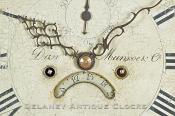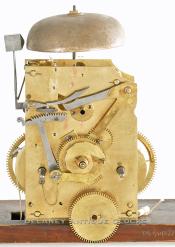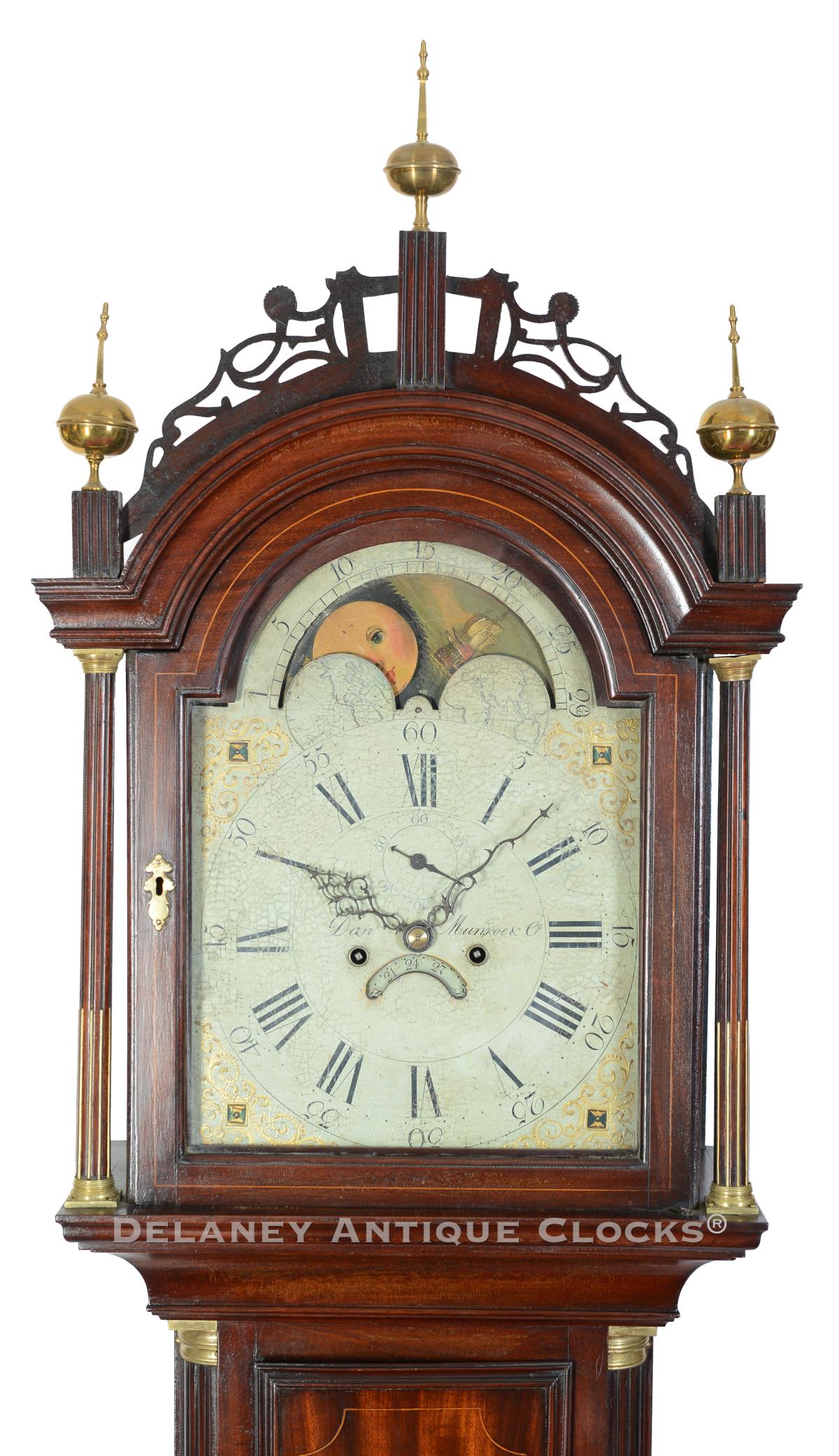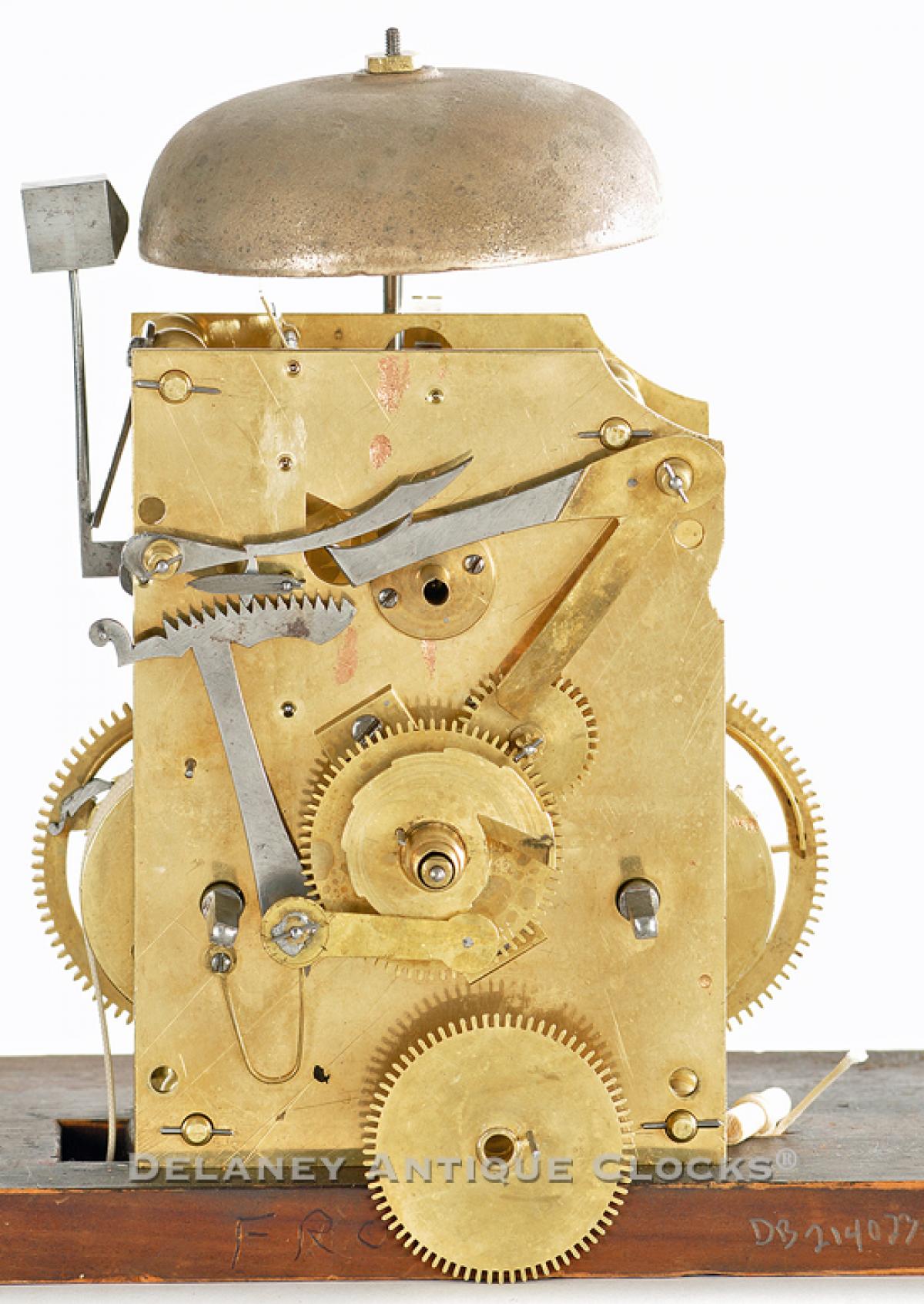Daniel Munroe & Co. Concord, MA. An inlaid mahogany cased tall case clock featuring outstanding proportions. 214023.
This wonderful mahogany cased example is nicely proportioned and features delicate line inlay patterns in the base, waist, and on the hood door. This case retains what appears to be an original finish. The case stands on four ogee bracket feet applied to the bottom of the base. The base panel features a good grain figure and is lined inlaid around the perimeter. This pattern features cut-out corners. The waist section is long and narrow. The sides of this case are fitted with brass stop-fluted quarter columns and brass quarter capitals. The waist door is rectangularly shaped and is also lined inlaid. An applied molding frames the outer edge of the door. The bonnet is topped with a New England-style fretwork pattern incorporating three ball-and-spiked brass finials. They sit on fluted plinths in this design. Fully turned bonnet columns are fluted and stopped with brass rods. These terminate in brass capitals that flank the line inlaid bonnet door. This door is fitted with glass and opens to allow one access to the painted iron dial.
This twelve-inch dial was made and painted in Boston and is attributed to the ornamental artist and dial manufacturer Spencer Nolen. The dial design is well executed and is signed on the front in script lettering "Daniel Munroe & Co." The four corner areas are decorated with a lacy pattern raised off the dial's surface with gesso. This decoration is then highlighted with gilt paint. A colorful medallion is centered in each pattern. In the arch, this dial is fitted with a moon phase or lunar calendar. This is colorfully paint-decorated. The time track is formatted with Roman-style hour figures. Each of the five-minute markers is indicated in Arabic form. The subsidiary seconds dial and month calendar are located in their traditional locations. This dial exhibits a fair amount of crackleture in the surface paint. It is stable and provides an interesting texture when viewing.
This fine movement is constructed in brass and is of good quality. Four-turned pillars support the two brass plates. Hardened steel shafts support the polished steel pinions and brass gearing. The winding drums are grooved. The escapement is designed in a recoil format. The movement is weight-driven and designed to run for eight days fully wound. It is a two-train or a time-and-strike design having a rack and snail striking system. As a result, it will strike each hour on the hour. This is done on a cast iron bell mounted above the movement.
This clock was made circa 1803 and is approximately 7 feet 10 inches tall to the top of the center finial.
This clock is inventory number 214023.
It is recorded that the firm of Daniel Munroe & Co. was comprised of Clockmakers Daniel Jr. and Nathaniel Munroe, and their younger brother William Munroe was the cabinet or case maker. This partnership began in 1798 and lasted until 1804.
Daniel Munroe Jr., Clockmaker, and silversmith, was born in Roxbury, Massachusetts, on July 13, 1775. Daniel Munroe Senior and his wife Abigail Parker had five sons. All five boys were raised in Roxbury. The Munroe family is well connected to American History and the clock trade. Daniel Senior's father, Jedediah Munroe, died in the Battle of Lexington. Daniel's mother, Abigail Parker of Roxbury, was the eldest daughter of Jonathan Parker. Jonathan, a farmer living in Roxbury, was one of the 13 Patriots who participated in the Boston Tea Party. This act of defiance against British rule and their taxation policies took place on Griffin's Wharf on December 16, 1773.
Daniel Jr. was trained in the art of clockmaking by America's most famous clockmaker, Simon Willard, in Roxbury. Daniel served the traditional seven-year apprenticeship. Simon wrote in a letter dated July 13, 1796, that described Daniel as "... one of the best workman in America." After serving his apprenticeship, Daniel worked for a short time as a journeyman clockmaker in Willards Roxbury clock shop before moving to Concord, Massachusetts, sometime before 1798. Here he kept a shop opposite the Clothing Mill and worked as a clockmaker and a silversmith. From 1798 through 1804, he formed a partnership with his brothers Nathaniel and William as Daniel Munroe & Co. William was a cabinetmaker and left the partnership in 1804. On November 29, 1804, William married Sarah Dakin (1781-1856) in Concord. The clockmaker partnership of Daniel and Nathaniel lasted another three years when in 1807, Daniel moved back to Boston and opened a shop located at 51 Newbury Street. While in Boston, he advertised being situated at several different Boston addresses, including No. 51 Ann Street, in 1809. In 1811, he was at No. 35 1/2 Cornhill Street; in 1813 and 1814, he formed a partnership with Ezekiel Jones as Munroe & Jones. By 1816, Daniel was working at No. 47 Cornhill Street, and then in 1823, he moved to No. 38 Congress Street. In 1839, he moved to New York City. He then moved back to Boston in 1841 through 1856. Daniel died in Boston on October 21, 1859.
Nathaniel Munroe was born in Roxbury, Massachusetts, on June 21, 1777. It is recorded that he learned clockmaking from Abel Hutchins of Concord, New Hampshire. Abel was an early apprentice of Simon Willard's. Nathaniel was in business with his brother Daniel between 1800-1807 and is listed as a Clockmaker and a Brass Founder. In 1808, he joined Samuel Whiting and the partnership Munroe & Whiting. In 1817 he moved south to Baltimore and continued to make clocks in what appeared to be small numbers.
William Munroe was also born in Roxbury on December 15, 1778. He served his apprenticeship to Nehemiah Munroe, a cabinetmaker who worked in Roxbury. In about 1800, his two brothers convinced him to move to Concord to build cases for their clocks. They formed a partnership, and he was given a contract in 1801 as a full partner in their business. In 1805, he married Patty Stone and took up residence in her mother's house. William made clock cases and furniture. During the War of 1812, cabinetmaking became a hard way to make a living. So William began to make pencils. In just two short years, he made upwards of 175,000 pencils a year. By 1840, he was the leader in the American pencil industry. William died in Concord on March 6, 1861.














